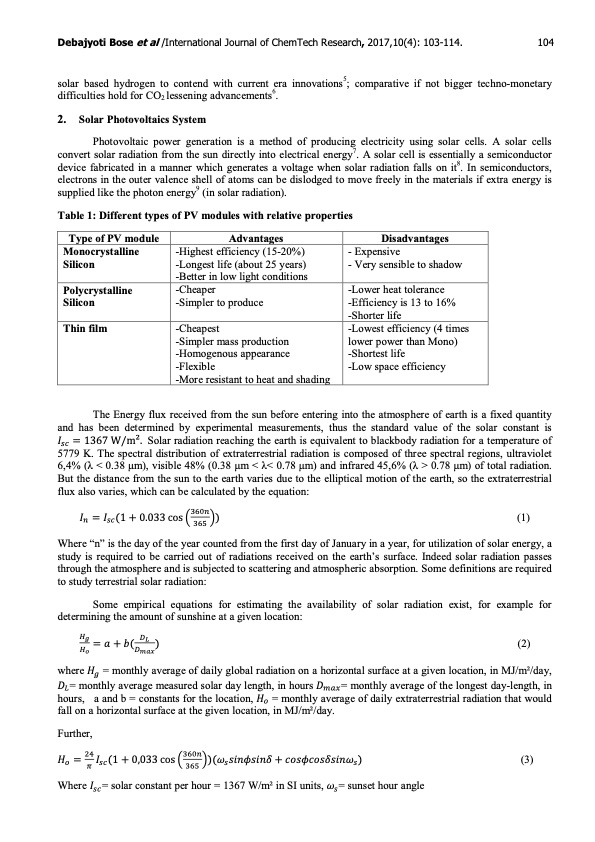
PDF Publication Title:
Text from PDF Page: 002
Debajyoti Bose et al /International Journal of ChemTech Research, 2017,10(4): 103-114. 104 solar based hydrogen to contend with current era innovations5; comparative if not bigger techno-monetary difficulties hold for CO2 lessening advancements6. 2. Solar Photovoltaics System Photovoltaic power generation is a method of producing electricity using solar cells. A solar cells convert solar radiation from the sun directly into electrical energy7. A solar cell is essentially a semiconductor device fabricated in a manner which generates a voltage when solar radiation falls on it8. In semiconductors, electrons in the outer valence shell of atoms can be dislodged to move freely in the materials if extra energy is supplied like the photon energy9 (in solar radiation). Table 1: Different types of PV modules with relative properties Type of PV module Monocrystalline Silicon Polycrystalline Silicon Advantages -Highest efficiency (15-20%) -Longest life (about 25 years) -Better in low light conditions -Cheaper -Simpler to produce Disadvantages - Expensive - Very sensible to shadow -Lower heat tolerance -Efficiency is 13 to 16% -Shorter life Thin film -Cheapest -Simpler mass production -Homogenous appearance -Flexible -More resistant to heat and shading -Lowest efficiency (4 times lower power than Mono) -Shortest life -Low space efficiency The Energy flux received from the sun before entering into the atmosphere of earth is a fixed quantity and has been determined by experimental measurements, thus the standard value of the solar constant is Solar radiation reaching the earth is equivalent to blackbody radiation for a temperature of 5779 K. The spectral distribution of extraterrestrial radiation is composed of three spectral regions, ultraviolet 6,4% (λ < 0.38 μm), visible 48% (0.38 μm < λ< 0.78 μm) and infrared 45,6% (λ > 0.78 μm) of total radiation. But the distance from the sun to the earth varies due to the elliptical motion of the earth, so the extraterrestrial flux also varies, which can be calculated by the equation: () (1) Where “n” is the day of the year counted from the first day of January in a year, for utilization of solar energy, a study is required to be carried out of radiations received on the earth’s surface. Indeed solar radiation passes through the atmosphere and is subjected to scattering and atmospheric absorption. Some definitions are required to study terrestrial solar radiation: Some empirical equations for estimating the availability of solar radiation exist, for example for determining the amount of sunshine at a given location: (2) where = monthly average of daily global radiation on a horizontal surface at a given location, in MJ/m2/day, = monthly average measured solar day length, in hours = monthly average of the longest day-length, in hours, a and b = constants for the location, = monthly average of daily extraterrestrial radiation that would fall on a horizontal surface at the given location, in MJ/m2/day. Further, () (3) Where = solar constant per hour = 1367 W/m2 in SI units, = sunset hour anglePDF Image | Renewable Electrolysis using Graphene electrodes

PDF Search Title:
Renewable Electrolysis using Graphene electrodesOriginal File Name Searched:
V10N4CT.pdfDIY PDF Search: Google It | Yahoo | Bing
Salgenx Redox Flow Battery Technology: Power up your energy storage game with Salgenx Salt Water Battery. With its advanced technology, the flow battery provides reliable, scalable, and sustainable energy storage for utility-scale projects. Upgrade to a Salgenx flow battery today and take control of your energy future.
| CONTACT TEL: 608-238-6001 Email: greg@infinityturbine.com | RSS | AMP |